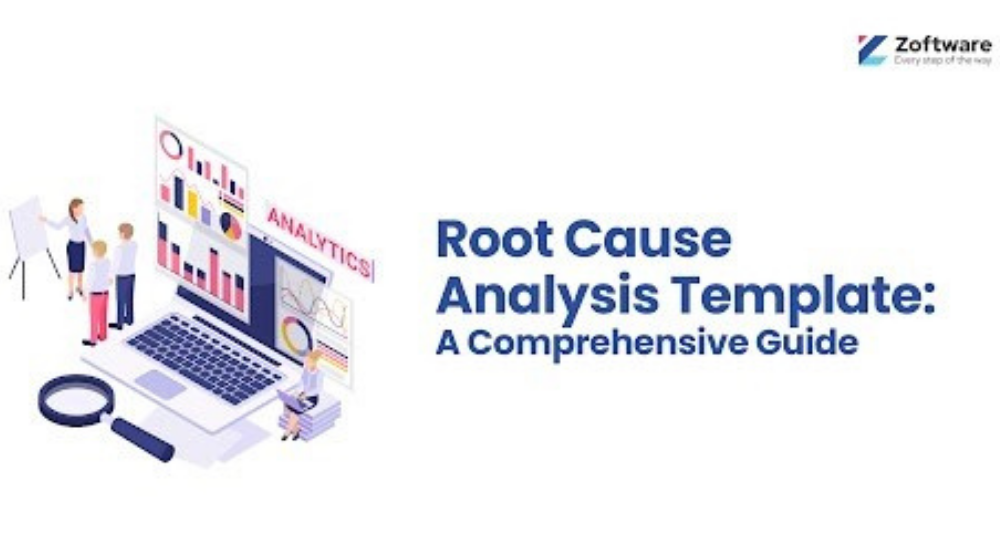Root cause analysis (RCA) is a problem-solving method that aims to identify the underlying causes of an issue, rather than just addressing the symptoms. It is a systematic approach that involves identifying the problem, collecting data, analyzing the data, and identifying the root cause of the problem. RCA is commonly used in industries such as healthcare, manufacturing, and information technology to improve processes, reduce errors, and prevent future incidents.
A root cause analysis template is a tool that helps guide the RCA process. It typically includes sections for problem identification, data collection, analysis, and identification of the root cause. Templates can be customized to fit the specific needs of an organization or industry. Using a template can help ensure that the RCA process is thorough and consistent, and that all relevant information is documented.
The Root Cause Analysis Process
- Define the problem: The first step in RCA is to define the problem clearly. This includes identifying the symptoms, the impact of the problem, and the timeline of events.
- Gather data: The next step is to gather data related to the problem. This includes collecting information about the process, the people involved, the equipment used, and any other relevant factors. The data can be collected through interviews, observations, and document reviews.
- Identify the root cause: Once the data is collected, the next step is to identify the root cause of the problem.
- Develop corrective actions: After identifying the root cause, the next step is to develop corrective actions. These actions should address the root cause of the problem and prevent it from recurring in the future.
- Implement corrective actions: The final step is to implement the corrective actions. This involves communicating the actions to the relevant stakeholders and monitoring their effectiveness.
It is important to note that RCA is an iterative process. If the corrective actions do not solve the problem, the RCA process may need to be repeated to identify additional root causes and develop new corrective actions.
In summary, the RCA process is a systematic approach to problem-solving that helps identify the underlying causes of a problem and develop effective solutions. By following the RCA process, organizations can improve their processes, reduce costs, and prevent future problems from occurring.
Components of a Root Cause Analysis Template
A root cause analysis (RCA) template is a tool used to identify the underlying causes of a problem or an incident. It is a systematic process that involves collecting data, analyzing it, and identifying the root cause of the problem. A good RCA template should have the following components:
1. Problem Statement
The problem statement is a clear and concise description of the problem or incident that occurred. It should include the who, what, where, when, and how of the problem. The problem statement should be specific and focused to help guide the RCA team in their investigation.
2. Data Collection
Data collection is an essential part of the RCA process. The RCA team should collect all relevant data related to the problem or incident. This can include incident reports, process maps, customer complaints, and any other relevant information. The data should be organized and presented in a way that is easy to analyze.
3. Cause and Effect Analysis
It involves analyzing the relationship between different factors and the problem. A cause and effect analysis can be done using a fishbone diagram or a mind map. The RCA team should use this technique to identify the underlying causes of the problem.
4. Solutions
Once the root cause of the problem has been identified, the RCA team should develop solutions to prevent the problem from occurring again. The solutions should be practical, effective, and easy to implement. The RCA team should also consider the cost and feasibility of implementing the solutions.
5. Action Plan
An action plan is a detailed plan that outlines the steps needed to implement the solutions. The action plan should include timelines, responsibilities, and resources needed to implement the solutions. The RCA team should also consider the potential risks and obstacles that may arise during the implementation process.
Using the Root Cause Analysis Template
When using a root cause analysis (RCA) template, it is important to follow a structured process to uncover the underlying causes of an issue or problem. The RCA template provides a framework for conducting a thorough analysis and identifying the root cause(s) of the problem.
The first step when using an RCA template is to define the problem or issue. This involves describing the problem in detail, including when it occurred, where it occurred, and what the impact was. It is important to be specific and provide as much detail as possible to ensure that the analysis is comprehensive.
Once the problem has been defined, the next step is to gather data. This involves collecting information about the problem, including any relevant documentation, reports, and data. It is important to gather as much data as possible to ensure that the analysis is thorough and accurate.
After the data has been gathered, the next step is to analyze the data. This involves reviewing the data and identifying any patterns or trends that may be relevant to the problem. It is important to be objective and unbiased when analyzing the data to ensure that the analysis is accurate.
Once the data has been analyzed, the next step is to identify the root cause(s) of the problem. This involves using tools such as the 5 Whys or Fishbone diagram to identify the underlying cause(s) of the problem. It is important to be thorough and consider all possible causes to ensure that the analysis is comprehensive.
Finally, once the root cause(s) have been identified, the next step is to develop a plan to address the problem. This involves identifying solutions to address the root cause(s) and implementing those solutions to prevent the problem from occurring in the future.
Tools for Root Cause Analysis
There are several tools available to assist in the RCA process, and selecting the right tool for the job can significantly improve the efficiency and effectiveness of the analysis.
The 5 Whys
This tool is easy to use and can be applied to a wide range of issues. By repeatedly asking “why,” the team can identify the underlying cause of the problem and develop appropriate solutions.
Fishbone Diagram
This tool is particularly useful when the root cause of the problem is not immediately apparent. The Fishbone Diagram allows the team to brainstorm and identify all possible causes of the problem, which can then be analyzed to determine the root cause.
Pareto Analysis
Pareto Analysis, also known as the 80/20 rule, is a statistical tool used to identify the most significant causes of a problem. This tool is particularly useful when there are multiple causes of a problem, and the team needs to prioritize which causes to address first. By identifying the most significant causes, the team can focus their efforts on addressing the root cause of the problem.
Fault Tree Analysis
Fault Tree Analysis (FTA) is a systematic approach to identifying the causes of a failure or problem. This tool is particularly useful in complex systems where multiple failures can occur. FTA involves breaking down the problem into smaller components and analyzing the potential causes of each component. By identifying the potential causes of each component, the team can determine the root cause of the problem.
Failure Mode and Effects Analysis (FMEA)
Failure Mode and Effects Analysis (FMEA) is a proactive approach to identifying potential failures and their effects. This tool is particularly useful in the design phase of a project, where the team can identify potential failures and develop appropriate mitigation strategies. FMEA involves identifying potential failure modes, determining the effects of each failure mode, and developing appropriate mitigation strategies.
8D Report Template Checklist
The 8D Report Template Checklist is a structured approach to problem-solving that involves eight steps. This tool is particularly useful when the problem is severe, and the team needs to take immediate action. The eight steps include: forming a team, describing the problem, containing the problem, identifying the root cause, developing and implementing corrective actions, verifying the effectiveness of the corrective actions, preventing recurrence, and congratulating the team.
DMAIC Template
DMAIC (Define, Measure, Analyze, Improve, Control) is a structured approach to problem-solving that is widely used in Six Sigma. DMAIC involves defining the problem, measuring the current performance, analyzing the data, improving the process, and controlling the process to prevent recurrence.
In conclusion, selecting the right tool for the job is critical to the success of the RCA process. Each tool has its strengths and weaknesses, and the team should select the tool that best fits the problem at hand.
Examples of Root Cause Analysis
Root cause analysis is a systematic approach that involves investigating the problem, collecting data, and analyzing the data to determine the root cause of the problem. Here are some examples of root cause analysis:
Example 1: Manufacturing Defects
A manufacturing company notices that there is a high rate of defects in one of their products. They decide to conduct a root cause analysis to determine the cause of the defects. The following steps are taken:
- Define the problem: The problem is the high rate of defects in the product.
- Collect data: Data is collected on the defects, including the type of defect, the frequency of the defect, and the location of the defect.
- Analyze the data: The data is analyzed to determine the root cause of the defects. It is found that the defects are caused by a malfunctioning machine that is not properly calibrated.
- Develop and implement a solution: The machine is repaired and recalibrated to prevent further defects.
Example 2: Customer Complaints
A customer service department receives a high number of complaints about a particular product. They decide to conduct a root cause analysis to determine the cause of the complaints. The following steps are taken:
- Define the problem: The problem is the high number of complaints about the product.
- Collect data: Data is collected on the complaints, including the type of complaint, the frequency of the complaint, and the location of the complaint.
- Analyze the data: The data is analyzed to determine the root cause of the complaints. It is found that the complaints are caused by a design flaw in the product.
- Develop and implement a solution: The product is redesigned to eliminate the design flaw and prevent further complaints.
Example 3: Workplace Accidents
A company experiences a high number of workplace accidents. They decide to conduct a root cause analysis to determine the cause of the accidents. The following steps are taken:
- Define the problem: The problem is the high number of workplace accidents.
- Collect data: Data is collected on the accidents, including the type of accident, the frequency of the accident, and the location of the accident.
- Analyze the data: The data is analyzed to determine the root cause of the accidents. It is found that the accidents are caused by a lack of safety training for employees.
- Develop and implement a solution: Safety training is provided to employees to prevent further accidents.
Common Mistakes in Root Cause Analysis
1. Focusing on Symptoms Instead of Root Causes
One of the most common mistakes in root cause analysis is focusing on symptoms rather than root causes. Symptoms are the visible effects or consequences of a problem, while root causes are the underlying factors that led to the problem. Focusing on symptoms can lead to superficial solutions that do not address the underlying causes of the problem. To avoid this mistake, it is important to dig deeper into the problem and identify the root causes.
2. Blaming Individuals Instead of Systems
Another common mistake in root cause analysis is blaming individuals instead of systems. It is easy to blame individuals for problems, but this approach ignores the fact that systems and processes can contribute to errors and accidents. To avoid this mistake, it is important to focus on the system and process factors that led to the problem, rather than blaming individuals.
3. Not Collecting Enough Data
Root cause analysis requires collecting and analyzing data to identify the underlying causes of problems. However, many organizations make the mistake of not collecting enough data or relying on incomplete or inaccurate data. To avoid this mistake, it is important to collect as much relevant data as possible and verify its accuracy before analyzing it.
4. Jumping to Conclusions
Another common mistake in root cause analysis is jumping to conclusions. It is important to take the time to thoroughly analyze the data and identify all possible root causes before drawing conclusions. Jumping to conclusions can lead to incorrect or incomplete solutions that do not address the underlying causes of the problem.
5. Not Implementing Effective Solutions
Finally, one of the most common mistakes in root cause analysis is not implementing effective solutions. Identifying the root causes of a problem is only the first step in the process. To avoid this mistake, it is important to evaluate the effectiveness of solutions and make adjustments as necessary.
Overall, avoiding these common mistakes can help organizations to conduct more effective root cause analysis and develop solutions. .
Conclusion
In conclusion, a root cause analysis template is a useful tool for identifying the source of a problem and developing an effective solution. By following the steps outlined in the template, organizations can identify the underlying causes of issues and take steps to prevent them from occurring in the future.




